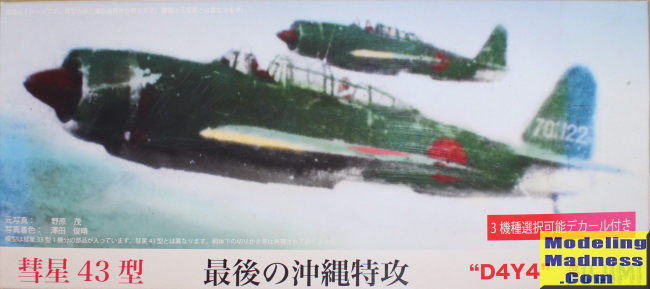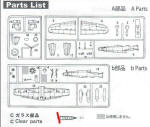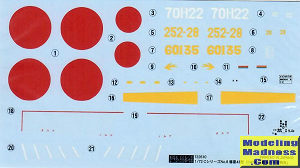
Fujimi 1/72 D4Y4 'Suisei
| KIT #: | 722610 (C-8) |
| PRICE: | 1400 yen |
| DECALS: | Three options |
| REVIEWER: | Tom Hall |
| NOTES: | Wrong underside |

| HISTORY |
The D4Y4, also known as the Suisei (Comet) Model 43 (Four Three), was the last of the D4Y series and was the heaviest variant of D4Y. The D4Y4 was planned as a special-attack aircraft, one that would attack in a relatively shallow dive and crash into its target. It is unlikely that any ever served aboard an aircraft carrier. It was manufactured by Aichi Kōkūki from February 1945 until the end of the war.
The change from Model 33 to 43 indicates a significant change to the airframe. Part of that change was the addition of armor plate and self-sealing fuel tanks, as well as the deletion of the sling for releasing a bomb in a steep dive. It is likely that the dive brakes were deleted. With no need for a bombsight through the windscreen, the windscreen reverted to the 3-pane style used for an earlier recon variant, the D4Y1-C, but a pane of armored glass was added at the centerline. The fuselage was revised to accommodate rockets, the number and layout of which changed early on. (Ultimately, the designers settled on two rockets aft of the bomb bay, providing ten seconds of acceleration in the final dive.) It was planned to carry a bomb for which the shallow bomb bay had not been designed. Bomb bay doors were replaced by fixed sheet metal with a cut-out that allowed the 800 kg bomb to protrude. It is said that many Model 43s were single-seaters, but some were two-seaters, possibly to carry a navigator.
| THE KIT |
 Fujimi’s
number 35130 was their first kit of a D4Y4, around 1996.
Fujimi’s
number 35130 was their first kit of a D4Y4, around 1996.
This kit, 722610, was released in 2015. It was not widely distributed in North America. The box top shows a hand-tinted photo of two D4Y4s in flight. Unfortunately, the kit does not match the illustration. The fuselage and wing lower piece are for the Model 33. They do not depict the forward cut-out for the 800 kg bomb or the aft cut-out for the rockets. Fujimi missed an opportunity to include the 800 kg bomb and the two rockets. The three-pane windscreen has been shaped properly for the Model 43, but it lacks the armored glass. (In this scale, the whole canopy is the thickness of scaled down armored glass!) The cockpit lacks any detailing of the fuselage sides. There are two seats molded onto the floor. Between them is a tall cylinder, which roughly represents a drift indicator that probably would not have been installed in the single-seat version of the plane. The Mitsubishi Kinsei 62 engine is represented as one-and-a-half rows of cylinders on a backing.
 The
instructions are straightforward but incorrectly depict the windscreen for the
dive bomber. (I have put a red line through it on the parts diagram.)
The
instructions are straightforward but incorrectly depict the windscreen for the
dive bomber. (I have put a red line through it on the parts diagram.)
Decals are for three naval air units. I question the choice of white for the marking “701-122”; yellow-orange may have been a better bet.
| CONCLUSIONS |
This is a model that is not exactly what is represented in the box art. Fujimi did not provide the cut-outs in the ventral fuselage, possibly because the exact appearance is unknown. However, this kit is a good start for making a Model 43.
| REFERENCES |
Famous Airplanes of the World, No. 69 Bunrindō Co., Ltd., Tōkyō, 1998
Tom Hall
March 2021 Copyright ModeingMadness.com. All rights reserved. If you would like your product reviewed fairly and fairly quickly, please contact the editor or see other details in the
Note to
Contributors. Back to the Main Page
Back to the Review
Index Page
Back to the Previews Index Page